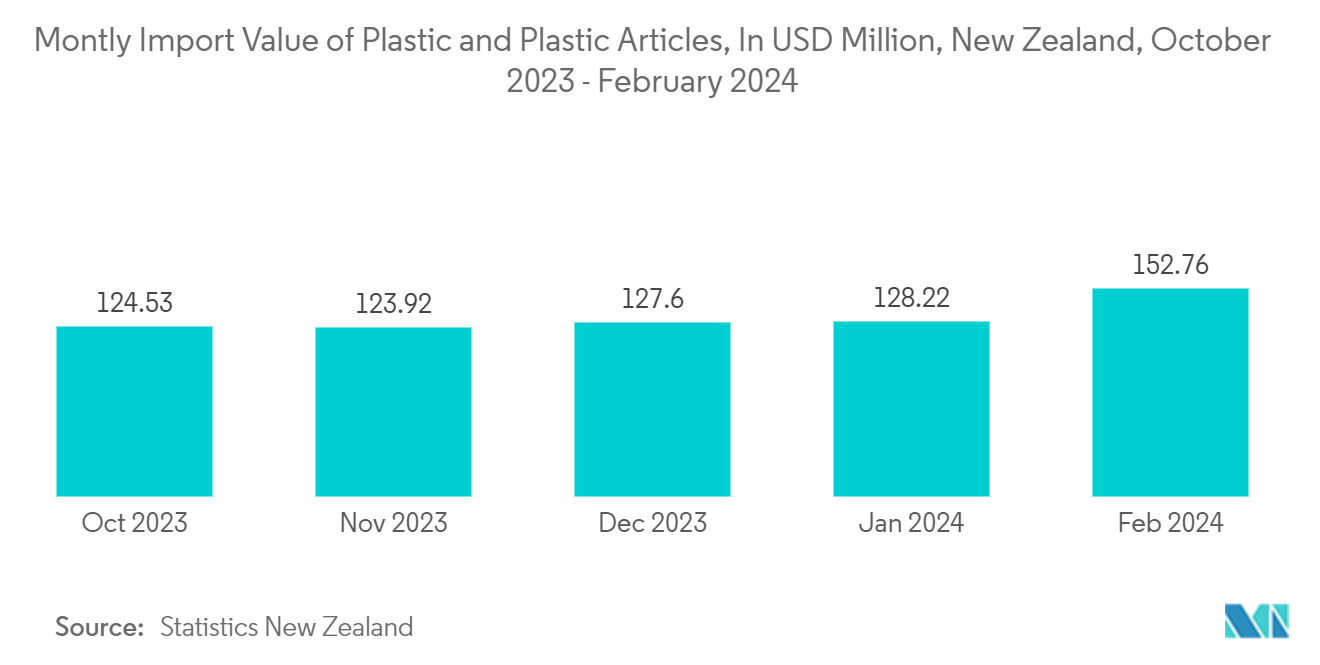Market Trends of Australia And New Zealand Plastic Bottles Industry
Recyclable Plastic Materials Such as Polyethylene Terephthalate (PET) To Witness Growth
- The industry manufactures and imports raw materials (polymers), designs and manufactures these into finished goods to meet consumer demand, and recovers and recycles these back into new raw materials for ongoing use in increasingly circular economies.
- In April 2024, The Asahi Group Australia supports adopting recycled PET bottles. Recycled PET bottles derive from PET resin sourced from repurposed PET bottles and others. Asahi Beverages, managing its non-alcoholic beverage division in Australia, has used recycled PET bottles for its Cool Ridge mineral water brand since 2019. The company is set on broadening this initiative, aiming for a complete transition to 100% recycled content in its PET bottles by 2030.
- Furthermore, in May 2023, Coca-Cola New Zealand announced a significant shift: after nearly 60 years, Sprite's iconic green plastic bottles will transition to clear plastic. This change aims to enhance recyclability, making the bottles more easily repurposed into new ones. Although green PET plastic is recyclable, it is typically converted into single-use items, such as clothing and carpets, which lack further recyclability. By moving from its signature green to clear bottles, the company is bolstering local recycling systems and enhancing the chances of these bottles being remade into new ones.
- Australia's plastic consumption is projected to more than double by 2050. Recently, the Australian Government has unveiled multiple initiatives targeting plastic waste reduction. These initiatives encompass the 2018 National Waste Policy, the 2019 National Waste Policy Action Plan, the Australian Packaging Covenant, and an ambitious target to recycle or reuse all plastic waste and eliminate plastic pollution by 2040.
- According to Statistics New Zealand, the import value of plastic and plastic articles in New Zealand in February 2024 was NZD 249 million (USD 152.76 million), up from NZD 203 million (USD 124.5 million) in October 2023. However, PET has become an essential resin, celebrated for its recyclability and promise of circularity. Collecting, processing, and reimagining used PET products into new packaging materials can significantly lessen the reliance on virgin resources and curb environmental waste.

Plastic Bottles Set for Robust Expansion in Beverage Sector
- The beverage market encompassing soft, energy, sports, and ready-to-drink (RTD) coffee has consistently grown. This upward trajectory is anticipated to persist, compelling the industry to swiftly adapt to current and emerging trends. Beyond seeking innovative flavours, consumers increasingly prioritise healthier options, reduced sugar content, and plant-based variants of their favourite beverages.
- According to Döhler, a global leader in producing and marketing technology-driven natural ingredients and integrated solutions for the food, beverage, and nutrition sectors, trends prioritizing naturalness, health, and plant-based nutrition dominate the beverage landscape in Australia and New Zealand. Notably, Kombucha, a contemporary fermented tea, has significantly increased in popularity.
- Furthermore, non-alcoholic beers have emerged as a leading force in the beer market. While global consumption of alcoholic beers sees only a modest uptick, non-alcoholic counterparts are swiftly capturing a larger slice of the market. This shift is particularly pronounced in Australia and New Zealand.
- Moreover, the appetite for non-alcoholic options is rising in the spirits domain. Globally, non-alcoholic spirits are projected to expand at an annual rate of 7.5% by 2024. Beyond low alcohol content, consumers are increasingly scrutinizing the sugar levels in their beverages. In Australia and New Zealand, there's a notable shift toward sugar-free or reduced-sugar versions of spirits. This would drive the demand for plastic bottles market.
- According to the Australian Bureau of Statistics, the consumer price index (CPI) for alcoholic beverages in 2020 was 117, and it reached 126.4 in 2023. The rising adoption of plastic bottles has become essential for numerous packaging enterprises in Australia and New Zealand. This surge is primarily fueled by the swift growth of Australia's beverage industry.
- Australia stands out as a leading consumer of plastic bottles. Data from Sustainability Victoria, the Australian government agency, reveals that Australians purchase nearly 15 billion plastic bottles annually, catering to household and commercial needs. The appetite for plastic bottles and containers continues to swell as the nation witnesses a surge in bottled water, soft drinks, and other ready-to-drink beverages.


